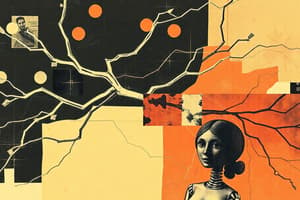Podcast
Questions and Answers
What is the role of glutamine synthetase?
What is the role of glutamine synthetase?
- Releasing glutamate from synaptic vesicles
- Activating ionotropic receptors
- Converting glutamate to glutamine (correct)
- Converting glutamine to glutamate
Which of the following is NOT a type of ionotropic receptor?
Which of the following is NOT a type of ionotropic receptor?
- GABA (correct)
- AMPA
- NMDA
- KA
What happens when NMDA receptors are activated?
What happens when NMDA receptors are activated?
- Only Na+ and K+ are allowed to pass through
- Only Ca2+ is allowed to pass through
- No ions are allowed to pass through
- Ca2+, Na+, and K+ are allowed to pass through (correct)
What is the function of VGLUT?
What is the function of VGLUT?
What is the effect of domoic acid on the body?
What is the effect of domoic acid on the body?
What is the characteristic of AMPA receptors that lack the GluA2 subunit?
What is the characteristic of AMPA receptors that lack the GluA2 subunit?
What is the major inhibitory neurotransmitter in the brain?
What is the major inhibitory neurotransmitter in the brain?
What is the effect of Picrotoxins on GABA receptors?
What is the effect of Picrotoxins on GABA receptors?
What type of receptors do neurotransmitters involved in diffuse neuronal systems mainly act on?
What type of receptors do neurotransmitters involved in diffuse neuronal systems mainly act on?
What is the function of inhibitory neurotransmitters?
What is the function of inhibitory neurotransmitters?
Which of the following is an example of an amino acid neurotransmitter?
Which of the following is an example of an amino acid neurotransmitter?
What is the process by which glutamate is released into the synaptic cleft?
What is the process by which glutamate is released into the synaptic cleft?
What is a characteristic of neuropeptides in the CNS?
What is a characteristic of neuropeptides in the CNS?
What is the effect of a lack of orexin or its receptors in animals?
What is the effect of a lack of orexin or its receptors in animals?
What is the primary use of Serotonin-Norepinephrine Reuptake Inhibitors (SNRIs)?
What is the primary use of Serotonin-Norepinephrine Reuptake Inhibitors (SNRIs)?
What is the primary function of endocannabinoids in the brain?
What is the primary function of endocannabinoids in the brain?
What is a common symptom of Major Depressive Disorder?
What is a common symptom of Major Depressive Disorder?
What is the characteristic of fluvoxamine?
What is the characteristic of fluvoxamine?
What is the enantiomer of citalopram?
What is the enantiomer of citalopram?
What is the role of orexin neurons in the sleep-wake cycle?
What is the role of orexin neurons in the sleep-wake cycle?
What is a function of somatostatin, a type of neuropeptide?
What is a function of somatostatin, a type of neuropeptide?
What is the primary use of Tricyclic Antidepressants (TCAs)?
What is the primary use of Tricyclic Antidepressants (TCAs)?
What is the characteristic of trazodone?
What is the characteristic of trazodone?
What is the characteristic of paroxetine?
What is the characteristic of paroxetine?
What is a common thought pattern in individuals with depression?
What is a common thought pattern in individuals with depression?
What is a common comorbidity associated with depression?
What is a common comorbidity associated with depression?
What is the primary use of antidepressants?
What is the primary use of antidepressants?
What is the role of neurotrophic factors in the neurotrophic hypothesis of depression?
What is the role of neurotrophic factors in the neurotrophic hypothesis of depression?
What is the hippocampus primarily responsible for?
What is the hippocampus primarily responsible for?
What is the outcome of effective antidepressant therapies on neurogenesis and synaptic connectivity?
What is the outcome of effective antidepressant therapies on neurogenesis and synaptic connectivity?
Flashcards are hidden until you start studying
Study Notes
Glutamate and Glial Cells
- Released glutamate acts on post-synaptic glutamate receptors.
- Glutamate is converted to glutamine in glial cells by the enzyme glutamine synthetase.
- In glia, glutamine is converted back to glutamate by the enzyme glutaminase.
Vesicular Transport and Excitation
- High concentrations of glutamate in synaptic vesicles are maintained by the vesicular glutamate transporter (VGLUT).
- Nearly all tested neurons are excited by glutamate through activation of ionotropic and metabotropic receptors.
Ionotropic Receptors
- Three main types of ionotropic receptors: AMPA, Kainic Acid (KA), and NMDA.
- AMPA receptors (contain GluA2 subunit) are permeable to Na+ and K+, but not Ca2+; some interneurons without GluA2 are Ca2+ permeable.
- KA receptors are permeable to Na+ and K+, and can be Ca2+ permeable depending on subunit composition.
- Domoic acid from shellfish can cause poisoning through excitatory action on KA and AMPA receptors, leading to symptoms like seizures.
- NMDA receptors are ubiquitous in the CNS, allowing Na+, K+, and Ca2+ permeability; they require extreme depolarization to open.
Inhibitory Neurotransmitters
- GABA and Glycine serve as primary inhibitory neurotransmitters.
- GABA is the major neurotransmitter in the brain, while Glycine is predominant in the spinal cord.
- Picrotoxins block GABA's effects by binding to GABA-A receptors causing convulsions.
Diffuse Neuronal Systems
- These systems have broad distribution and varied activities, innervating multiple CNS regions.
- Neurotransmitters involved include norepinephrine, dopamine, and serotonin (5HT), affecting a range of functions like sleep, attention, and emotional states.
- Primarily activate metabotropic receptors for long-lasting synaptic effects.
Neurotransmitter Categories
- Excitatory neurotransmitters trigger action potentials.
- Inhibitory neurotransmitters inhibit action potential transmission.
- Major amino acid neurotransmitters include glutamate, GABA, and glycine.
Neuropeptides and Functions
- Neuropeptides co-exist with conventional neurotransmitters, influencing functions such as reproduction, social behavior, appetite, pain, and learning.
- Opioid peptides like enkephalins and endorphins are included.
Orexin/Hypocretins
- Produced in the hypothalamus, orexins are excitatory neurotransmitters that regulate wakefulness and energy homeostasis.
- Lack of orexin or its receptors leads to narcolepsy and disturbed sleep patterns.
Other Signaling Substances
- Endocannabinoids are psychoactive compounds affecting cognition and pain perception.
- Nitric oxide and purines (ATP, UTP, adenosine) also act as signaling molecules in the CNS.
Antidepressant Agents
- Major Depressive Disorder (MDD) presents with persistent depressed mood, loss of interest, sleep and appetite disturbances, and cognitive deficits.
- Selective serotonin reuptake inhibitors (SSRIs) such as fluoxetine and escitalopram have varying half-lives and inhibit cytochrome P450 enzymes.
- Serotonin-Norepinephrine Reuptake Inhibitors (SNRIs) include venlafaxine and duloxetine, treating pain disorders and anxiety.
Tricyclic Antidepressants (TCAs)
- TCAs like imipramine and amitriptyline are used for treatment-resistant depression.
- 5HT2 receptor modulators such as trazodone block 5HT2A receptors and are often prescribed as sleep aids.
Tetracyclic and Unicyclic Antidepressants
- Similar to TCAs but infrequently prescribed.
- Depression increases risks for coronary artery disease, diabetes, and stroke.
MDD Pathophysiology
- Monoamine hypothesis suggests low monoamine levels in MDD.
- Neurotrophic hypothesis emphasizes the role of neurotrophic factors in neural plasticity and resilience.
- Brain-derived neurotrophic factor (BDNF) links effective antidepressant therapy to neurogenesis and synaptic connectivity, particularly in the hippocampus, which is crucial for memory and hormone release regulation.
Studying That Suits You
Use AI to generate personalized quizzes and flashcards to suit your learning preferences.




